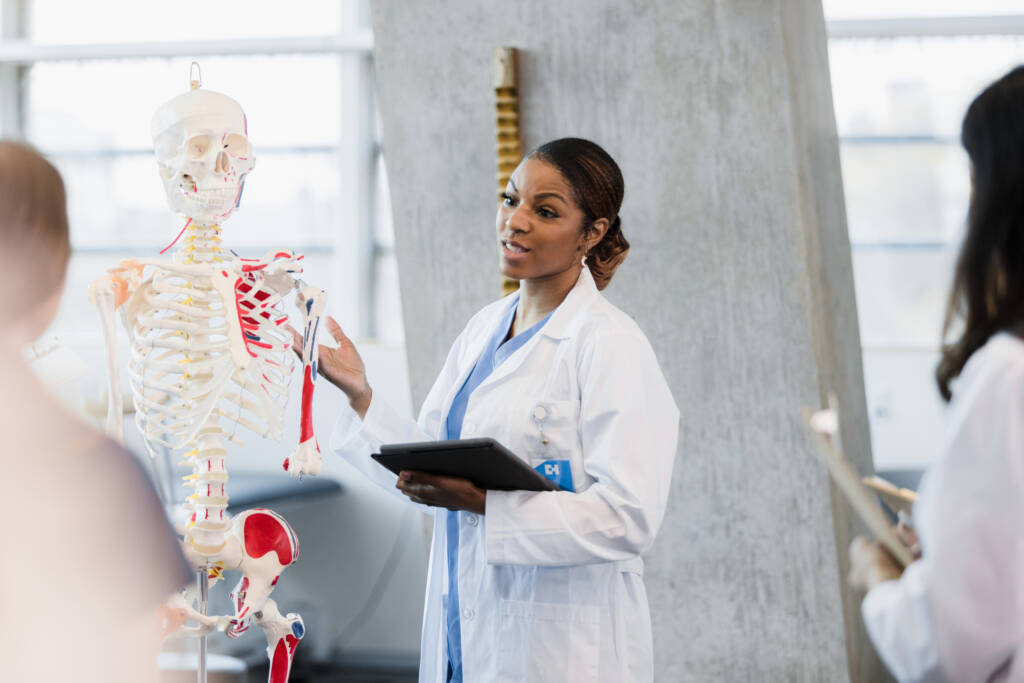
Adult Education Medical Terminology 1b

Our bodies are complex, and when we start feeling ill, a doctor or specialist must analyze and diagnose what could be wrong. Learn about different diagnostic technology, procedures, essential body systems, and fluids that need to be understood to make an accurate diagnosis of a disease, condition, or illness. This career field is flourishing, and now is the time to be part of it!
During this course, you will learn career-related skills and earn a badge for this accomplishment. A badge is a digital certification of your career-related learning that you can share on social media or with higher education platforms, colleges, potential employers, peers, and colleagues. Select this link to learn more about badges.
Major Topics and Concepts
Unit 1:
- Describe the parts of the X-ray tube
- Explain how X-rays are produced, their properties, and how they interact with the body
- Identify factors that influence image quality
- Investigate the role of digital radiography in PACS and telemedicine
- Differentiate between screen film, computed, and direct radiography systems
Unit 2:
- Describe the parts of the respiratory and cardiopulmonary systems and their functions
- Use the medical terminology of the cardiopulmonary system to define words related to this system
- Identify methods of assessing respiratory patients, including normal and abnormal results
- Describe the tools and tests used to evaluate and diagnose lung conditions and diseases
- Explain the difference between restrictive and obstructive lung disease, and give examples of each type
Unit 3:
- Describe the structure and function of the parts of the cardiovascular system
- Discuss circulatory pathways and the electrical conduction pathway of the heart
- Recognize the signs and symptoms of cardiopulmonary compromise and identify the appropriate response
- Name tests and procedures used to diagnose and treat cardiovascular conditions
- Explain careers, including educational requirements, certification, and licensure, involving the cardiovascular system
Unit 4:
- Explain how the heart’s electrical conduction pathway corresponds to the waveform produced on an electrocardiogram
- Identify how to set up for an electrocardiogram, including electrode placement, infection control measures, maintenance of equipment, and troubleshooting
- Describe the types of tests that use electrocardiograms
- Analyze ways to adapt to changes in patient conditions in relation to the performance and interpretation of an electrocardiogram
- Differentiate between normal rhythms and arrhythmias as well as respond appropriately to life-threatening arrhythmias
Unit 5:
- Identify the structures and functions of tissues, membranes, and glands
- Describe the tools and tests used to diagnose conditions related to tissues, membranes, and glands
- Discuss the structures and functions of the reproductive system and tests used to diagnose related conditions
- Explain other special tests used to diagnose patient conditions such as sleep disorders, allergies, and psychological concerns
Unit 6:
- Identify and explain the functions of muscular system structures
- Discuss conditions related to the muscular system and some tests used to diagnose them
- Name and provide details on the functions of endocrine system structures
- Describe conditions related to the endocrine system and some tests used to diagnose them
Unit 7:
- Identify and describe the structures and functions of the parts of the gastrointestinal system
- Describe conditions of the gastrointestinal system
- Describe types of contrast media and the potential complications of using each type
- Explain multiple procedures that use contrast media to aid in diagnosis
- Recognize additional steps needed in the patient care process when using contrast media
Unit 8:
- Provide brief histories of radiology, medical laboratory, EKG, and pulmonary function testing
- Discuss how electronic health records and patient portals impact healthcare systems
- Explain how telemedicine is changing the care process as it relates to medical diagnostic technology
- Consider the use of robotics in healthcare, including barriers to implementation and potential benefits
- Describe the effect technology has on epidemiology and managed care
Competencies
Blood, Lymph, and Immune System Terminology
Students will demonstrate an understanding of the blood, lymph, and immune systems by describing the blood, lymph, and immune systems, decoding word parts and abbreviations and explaining blood, lymph, and immune system disorders.
Digestive System Terminology
Students will demonstrate an understanding of digestive system terminology by describing the digestive system, decoding word parts and abbreviations, and explaining digestive disorders.
Endocrine System Terminology
Students will demonstrate an understanding of endocrine system terminology by describing the endocrine system, decoding word parts and abbreviations, and explaining endocrine disorders.
Medical Specialties Terminology
Students will demonstrate an understanding of medical specialties terminology by describing medical specialty areas, decoding word parts and abbreviations, and explaining specialty disorders.
Medical Terminology in the Healthcare Setting
Students will demonstrate an understanding of medical terminology in the healthcare setting by describing body systems, decoding word parts and abbreviations, and explaining multi-system disorders.
Reproductive Terminology
Students will demonstrate an understanding of reproductive system terminology by describing the reproductive system, decoding word parts and abbreviations, and explaining reproductive system disorders.
Special Senses Terminology
Students will demonstrate an understanding of special senses terminology by describing the special senses, decoding word parts and abbreviations, and differentiating sight and hearing disorders.
Urinary System Terminology
Students will demonstrate an understanding of urinary system terminology by summarizing the urinary system, decoding word parts and abbreviations, and explaining urinary system disorders.

